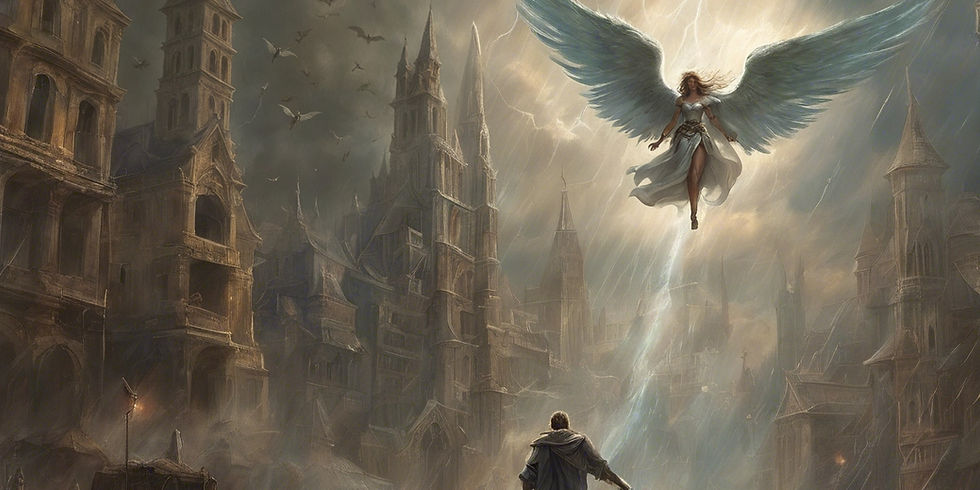Running Epic High Fantasy campaigns in D&D and other TTRPGs
- Lorelis Eathalen

- Sep 23, 2024
- 3 min read

Epic high fantasy campaigns are a staple of D&D and other TTRPGs, offering players the chance to become legendary heroes in worlds full of magic, political intrigue, and large-scale battles. To master this type of campaign, it’s important to understand several key concepts: the differences between high and low fantasy, high and low magic settings, and epic vs. slice-of-life storytelling.
High Fantasy takes place in fully fictional worlds with their own rules, such as The Lord of the Rings or Dungeons & Dragons’ settings. Low Fantasy is grounded in the real world but includes fantastical elements—think Harry Potter or Call of Cthulhu.
High Magic settings feature abundant magic and powerful spells (e.g., Harry Potter or Forgotten Realms), while Low Magic settings treat magic as rare or dangerous (Game of Thrones' Westeros or Tolkien's Middle Earth).
Epic Fantasy involves world-altering stakes, ancient evils, and godlike foes, with characters ascending to legendary status. Slice-of-Life Fantasy focuses on smaller, personal stories where the stakes are localized and characters remain tied to their origins.
Running Epic High Fantasy Campaigns
Embrace world-building at scale
In epic high fantasy, the world itself is a major character. You need to create a rich setting full of mythical kingdoms, ancient lore, and sprawling geography. Players should feel like their actions impact not just the immediate plot, but the entire world. In D&D, this means letting players interact with larger-than-life figures—such as gods, kings, and ancient dragons—and embroiling them in conflicts that can change the course of history. Consider integrating world-spanning factions, political intrigue, or conflicts between empires to add depth and scale.
Create monumental threats
Epic high fantasy campaigns are defined by colossal stakes. Whether it's an ancient evil returning after centuries, a looming apocalyptic event, or a war between gods, the threat must feel immense. The players should be the only hope against overwhelming odds. Introduce powerful antagonists early and allow the players to build up toward their final confrontation through smaller encounters that hint at the greater evil. The heroes’ journey from humble adventurers to legendary saviors is the backbone of an epic high fantasy story.
Make magic feel grand
In high fantasy, magic isn't just a tool—it's a force that shapes the world. High magic settings mean your world is full of enchanted artifacts, ancient rituals, and powerful spellcasters who influence history. Consider introducing magic with global consequences: entire cities levitated by arcane power or massive magical disasters reshaping continents. Make sure your players feel the awe of these wonders. Allow them to discover powerful spells and legendary items, reflecting their progression into mythic heroes.
Balance heroic arcs with personal growth
While epic fantasy focuses on grand scales and high stakes, don't neglect personal stories. Even as the players are saving kingdoms and toppling gods, their characters should face internal struggles. Conflicts of loyalty, personal rivalries, and moral dilemmas keep the story grounded. Show how the burden of saving the world affects their relationships and sense of self. This balance between personal and epic stakes is key to keeping players invested in both the world and their characters.
Keep pacing dynamic
Epic high fantasy campaigns are long journeys. Break up the grand quests with moments of downtime, smaller challenges, and character-driven side plots. This creates a rhythm that builds anticipation for the next epic showdown. Allow the players to explore the world at their own pace, creating moments of awe and wonder as they journey through vast, diverse landscapes. Keeping the pacing dynamic ensures the campaign feels like an epic tale unfolding, rather than a sprint from battle to battle.
By focusing on these elements, your epic high fantasy campaign will leave players feeling like they’ve stepped into a legend, fighting world-changing battles and forging their names in history.
More insights from knowledgeable peers
DungeonCraft discusses running high fantasy campaigns in TTRPGs. He covers topics like Joseph Campbell's monomyth, Carl Jung's archetypes, and distributing magic items to players. He provides insight into crafting epic narratives and memorable characters.
Captured in Words discusses the differences between high fantasy and low fantasy. High fantasy takes place in fictional worlds, while low fantasy adds supernatural elements into the real world. He provides examples of each subgenre and their defining characteristics.
Crucibles to try out in your next epic fantasy session
Create a Big Threat: Introduce an ancient evil or world-shaking event that only the players can stop, hinting at its power through smaller encounters.
Grand Magic Moments: Add a magical event that reshapes the world, like a floating city or a magical disaster, to make magic feel truly epic.
Kingdoms and Empires: Let players interact with kings, queens, or gods, making their actions impact the world’s political landscape.
Heroic Growth: Add personal challenges, like a moral dilemma or conflict with a party member, to balance epic stakes with character growth.



Comments